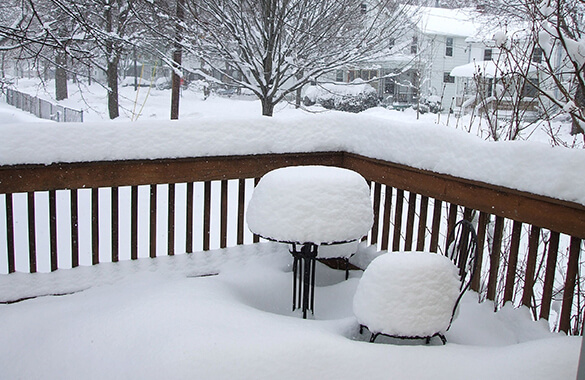As beautiful as snow is, it brings with it the possibility of damage to your basement and other areas of your home. Preparing for snow now can prevent problems later. Follow these steps to keep snow, ice and runoff from causing harm to your basement and your property.
Snow Preparation Tips
1. Clear roof gutters of debris. Mend or replace gutters that are damaged.
2. If water drains from the downspout near the home’s foundation, extend the drain so that water exits a few feet farther away.
3. Apply waterproofing compounds to seal basement walls.
4. Caulk any remaining seams and cracks through which water could enter.
5. Clear the basement egress window well of any debris that has accumulated, and close the egress window well cover.
6. If there are spots next to the basement where the ground slopes toward the basement instead of away, add fill.
7. Shut off exterior water outlets. Insulate pipes.
8. Stock bags of sand for use in case there is a need to divert water quickly and to provide traction on icy surfaces.
9. Add a supply of rock salt or other products capable of melting ice.
10. Locate all electrical breakers as well as the shutoff valves for water and heating fuel. Teach members of your household how and when to use them.
11. Be sure that your home’s smoke and carbon monoxide detectors are working, and keep a supply of fire extinguishers on all levels of your home. More home fires occur in winter than at any other time of year.
12. Survey your basement for things that would be damaged should water enter the basement. Elevate valuable items wherever possible. Reduce clutter.
13. If snow or wind could cause tree branches to break that would fall on your home, consider pruning the tree.
14. Make sure that chimneys or vents from fuel-burning equipment are clean and unobstructed.
Snow Management
Do Not Let Snow Cover Vents
Accumulating snow creates many problems. If it builds up on your roof to where it covers any of the vents, fumes may enter the house. If fumes back up into your heat source, they may cause an explosion. Whether you are at home or away, find some way to ensure that vents are kept clear. Usually, this can be done by simply keeping the heat on in your home. However, it may require removal of snow on and around the vents, either by hand or with the use of a shovel or blower, so be aware.
Remove Snow Overload
Melting snow forms ice, and ice is heavy. If too much snow and ice accumulates on your roof, the roof may cave in. Pressure caused by downward forces can also compromise the structural integrity of the rest of your home. If there’s a lot of snow and ice on your roof and you hear loud popping noises, find a way to reduce the load.
Keep Window Well Covers Free of Snow
Remove snow from your basement’s egress window well covers after every storm. Make sure each egress window well cover opens easily. If ice has formed, chip it away to free the cover.
Pile Snow Away From the Foundation
To protect your basement from snowmelt, pile snow away from the foundation. Oftentimes, in the spring, the ground is still frozen when water starts to run. Since frozen soil can’t absorb moisture, the water has to find somewhere else to go. Do all you can to channel it elsewhere.
Enjoy Winter!
With forethought, preparation and a few snow management steps, you can keep your basement drier and your home more secure. Snow season can mean problems, or it can mean fun for you and your family. Protect your home, and have fun!
